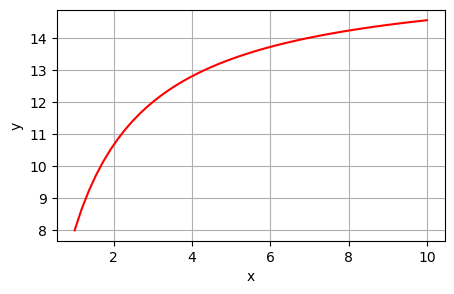Code
import numpy as np
import matplotlib.pyplot as plt
from scipy.integrate import odeint
import sympy as spZeigen Sie, dass die Funktion \(y(x) = C\frac{x}{1 + x}\) die allgemeine Lösung der Differentialgleichung \(x(1+x)y'(x) - y(x) = 0\) ist. Wie lautet die partikuläre Lösung zum Anfangswert \(y(1)=8\)? Erstellen Sie in Python einen Plot der partikulären Lösung.
Die Aufladung eines Kondensators der Kapazität \(C\) ab dem Zeitpunkt \(t=0\) über einen ohmschen Widerstand \(R\) auf die Endspannung \(u_0\) erfolgt nach dem Exponentialgesetz \(u_C(t) = u_0 (1- e^{-\frac{t}{RC}})\). Skizzieren Sie die Funktion \(u_C(t)\). Zeigen Sie, dass diese Funktion eine partikuläre Lösung der Differentialgleichung \(RC\dot{u_C}(t) + u_C(t) = u_0\) ist, die diesen Einschaltvorgang beschreibt. Erstellen Sie in Python Plots der Funktion \(u_C(t)\) für verschiedene Werte von \(C\) und \(R\).
Quellen:
Lösen Sie folgende DGL mit der Methode der Trennung der Variablen und überprüfen Sie jeweils Ihre Ergebnisse am Computer mittels SymPy.
Quellen:
Überprüfen Sie, ob die DGL exakt ist, und lösen Sie das Anfangswertproblem.
\[\dot{y} = \frac{-y^2}{2yt + 1}, \quad y(1)=-2\]
Quelle: Bronson: Schaum’s “Differential Equations”, p.36
Gegeben ist die Differentialgleichung \(y' = \frac{-2xy}{1 + x^2}\).
Quelle: Bronson: Schaum’s “Differential Equations”, Aufgaben 5.2 und 5.11, S. 33 und 36
Lösen Sie das folgende Anfangswertproblem \(yy' = \cos(2x), y(0) = -1\).
Ist die Differentialgleichung \(\dot{y}(t) = \frac{t + \sin(y(t))}{2y(t) - t\cos(y(t))}\) exakt? Begründen Sie Ihre Antwort. Geben Sie die allgemeine Lösung der Differentialgleichung in impliziter Form an.
Ein Auto mit Masse \(m\) und Anfangsgeschwindigkeit \(v_0\) bewegt sich nur unter dem Einfluss des als quadratisch von der Geschwindigkeit abhängig angenommenen Luftwiderstands.
Lösen Sie das Anfangswertproblem
\[y' = \frac{-x}{y}, \; y(0)=1.\]
Quelle: Farlow: Introduction to Differential Equations. Example 3, p. 40f.

\(\displaystyle y{\left(t \right)} \frac{d}{d t} y{\left(t \right)} = t e^{t}\)
\(\displaystyle \left[ y{\left(t \right)} = - \sqrt{2} \sqrt{C_{1} + t e^{t} - e^{t}}, \ y{\left(t \right)} = \sqrt{2} \sqrt{C_{1} + t e^{t} - e^{t}}\right]\)
\(\displaystyle \left(t^{2} + 1\right) \frac{d}{d t} y{\left(t \right)} = t y{\left(t \right)}\)
\(\displaystyle \frac{d}{d t} y{\left(t \right)} = - \frac{y^{2}{\left(t \right)}}{2 t y{\left(t \right)} + 1}\)
\(\displaystyle \left[ y{\left(t \right)} = \frac{- \sqrt{C_{1} t + 1} - 1}{2 t}, \ y{\left(t \right)} = \frac{\sqrt{C_{1} t + 1} - 1}{2 t}\right]\)
\(y(x) = -\sqrt{\sin(2x) + 1}\)
\(\frac{t^2}{2} + t\sin(y) - y^2 = c\)
ist exakt, \(y=\sqrt{1 - x^2}\)